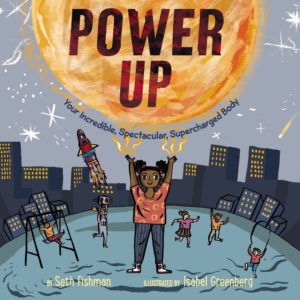 By Terri Schlichenmeyer, NDG Contributing Writer
By Terri Schlichenmeyer, NDG Contributing Writer
You are a really great kid.
You can run fast and jump high. You can smile and sing and catch a ball. You might even know how to make a sandwich or help out around the house. You’re pretty awesome all around, but in “Power Up” by Seth Fishman, illustrated by Isabel Greenberg, you’re insides are especially incredible.
Here’s something you might not know: You’re a fireball from the skies.
No, really. If you could look inside your body, you’d find the same ingredients that make stars. And get this: if you could harness it properly, your littlest finger on your right hand has energy enough to run millions of refrigerators and TVs, light up hundreds of schools, and run an entire city’s worth of stoplights. All on the same day!
It takes energy to do everything; even just sitting and listening to music or reading a piece of paper takes energy. The bones and muscles inside you take energy to keep you singing and jumping and smiling, from the smallest bone inside your head to the largest bone in your thigh, from the smallest muscle in your ear to your largest muscle, the one you’re sitting on!
Human beings have energy to run longer than the fastest animal on earth. They can create musical instruments and make songs. Humans learned to cook food, to invent cars and trains, to build cities and sidewalks, and to look for stars in the skies. Maybe we’re even looking for another fireball…
The thing to remember about the energy inside your body is that sometimes, it needs to replenish. That can be done by eating food that’s good for you, getting a full nights’ sleep, and being active every day. If you get all these things and you take care of the energy machine that is your body, then your brain is cared-for, too.
And that brain? It lets you imagine and invent, do math, work on a computer and understand science, remember important things and unimportant things. It keeps you interesting, funny, and smart. It makes you powered up.
Time and again, in a dozen ways, you’ve told your child that he or she is important and special. He knows it’s true. Let “Power Up” show her in even more ways.
Through quickly-read pages brimming with facts, and artwork that’s as action-packed as the words it accompanies, author Seth Fishman and illustrator Isabel Greenberg teach their audience with a “gee-whiz” tone that takes information to kid-level but without dumbing it down. Young readers may be skeptical at what they’ll learn (you might, too!) but Fishman takes care of that by including two pages in the back of his book to further explain the science and biology involved. That underscores what’s mentioned in earlier pages and it will encourage a deeper curiosity and interest in further exploration.
For the 4-to-8-year-old who goes nonstop, this is a great introduction to STEM learning, and it’s fun to read, too. “Power Up” could be the right book for the greatest kid you know.




